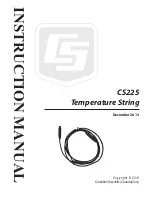
CHAPTER 10: THEORY OF OPERATION
OVERVIEW
L90 LINE CURRENT DIFFERENTIAL SYSTEM – INSTRUCTION MANUAL
10-9
10
It is not necessary to exchange stamps with every relay, and the method works even with some of the channels failed. For
each relay that a given relay can exchange time stamps with, the clock deviation is computed each time a complete set of
time stamps arrives. The net deviation is the total deviation divided by the total number of relays involved in the exchange.
For example, in the case of two terminals, each relay computes a single time deviation from time stamps, and divides the
result by two. In the case of three terminals, each relay computes two time deviations and divides the result by three. If a
channel is lost, the single deviation that remains is divided by two.
Four time stamps are needed to compute round-trip delay time and phase deviation. Three stamps are included in the
message in each direction. The fourth time stamp is the time when the message is received. Each time a message is
received, the oldest two stamps of the four time stamps are saved to become the first two time stamps of the next
outgoing message. The third time stamp of an outgoing message is the time when the message is transmitted. A fixed
time shift is allowed between the stamp values and the actual events, provided the shift for outgoing message time
stamps is the same for all relays, and the shift incoming message time stamps is also identical.
To reduce bandwidth requirements, time stamps are spread over three messages. In the case of systems with four
messages per cycle, time stamps are sent out on three of the four messages, so a complete set is sent once per cycle. In
the case of systems with one message per cycle, three time stamps are sent out each cycle in a single message. The
transmit and receive time stamps are based on the first message in the sequence.
One of the strengths of this approach is that it is not necessary to explicitly identify or match time stamp messages.
Usually, two of the time stamps in an outgoing message are simply taken from the last incoming message. The third time
stamp is the transmittal time. However, there are two circumstances when these time stamps are not available. One
situation is when the first message is transmitted by a given relay. The second is when the exchange is broken long
enough to invalidate the last received set of time stamps (if the exchange is broken for longer than 66 ms, the time stamps
from a given clock can roll over twice, invalidating time difference computations). In either of these situations, the next
outgoing set of time stamps is a special start-up set containing transmittal time only. When such a message is received,
nothing is computed from it, except the message time stamp and the received time stamp are saved for the next outgoing
message (it is neither necessary nor desirable to “reset” the local clock when such a message is received).
Error analysis shows that time-stamp requirements are not very stringent because of the smoothing behavior of the phase
locked loop. The time stamp can be basically a sample count with enough bits to cover the worst round trip, including
channel delay and processing delay. An eight-bit time stamp with one bit corresponding to 1/64 of a cycle accommodates
a round trip delay of up to four cycles, which is likely to be more than adequate.
The computation of round trip delay and phase offset from four time stamps is as follows:
Eq. 10-26
The Ts are the time stamps, with T
i
the newest. Delta is the round trip delay. Theta is the clock offset, and is the correct sign
for the feedback loop. Note that the time stamps are unsigned numbers that wrap around, while a and b can be positive or
negative;
δ
i
must be positive and
θ
i
can be positive or negative. Some care must be taken in the arithmetic to take into
account possible roll over of any of the time stamps. If T
i – 2
is greater than T
i – 1
, there was a roll over in the clock
responsible for those two time stamps.
To correct for the roll over, subtract 256 from the round trip and subtract 128 from the phase angle. If T
i – 3
is greater than
T
i
, add 256 to the round trip and add 128 to the phase angle. Also, if the above equations are computed using integer
values of time stamps, a conversion to phase angle in radians is required by multiplying by
π
/ 32.
Time stamp values are snapshots of the local 256 bit sample counter taken at the time of the transmission or receipt of the
first message in a time-stamp sequence. This can be done either in software or hardware, provided the jitter is limited to
less than plus or minus 130 µs. A fixed bias in the time stamp is acceptable, provided it is the same for all terminals.
















































